
Senecio is a genus of flowering plants in the daisy family (Asteraceae) that includes ragworts and groundsels.

Ceropegia woodii is a flowering plant in the dogbane family Apocynaceae, native to South Africa, Eswatini and Zimbabwe. It is sometimes treated as a subspecies of the related Ceropegia linearis, as C. linearis subsp. woodii. Common names include chain of hearts, collar of hearts, string of hearts, rosary vine, hearts-on-a-string, and sweetheart vine.
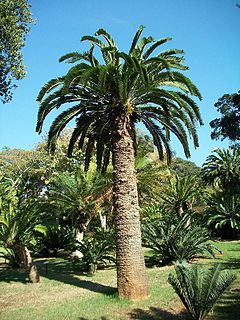
Encephalartos woodii, Wood's cycad, is a rare cycad in the genus Encephalartos, and is endemic to the oNgoye Forest of KwaZulu-Natal, South Africa. It is one of the rarest plants in the world, being extinct in the wild with all specimens being clones of the type. The specific and common name both honour John Medley Wood, curator of the Durban Botanic Garden and director of the Natal Government Herbarium of South Africa, who discovered the plant in 1895.

John Medley Wood was a South African botanist who contributed greatly to the knowledge of Natal ferns, is generally credited with the establishment of sugarcane mosaic virus immune Uba sugar cane in Natal and for his extensive collection of Natal plants.

Caputia tomentosa, known as the woolly senecio and the matted caputia, is a perennial, succulent dwarf shrub of the Caputia genus that grows in the Cape Provinces of South Africa, usually between the altitudes of 900 and 1200 meters. It has been introduced to Myanmar. It has gained the Royal Horticultural Society's Award of Garden Merit as an ornamental.

Senecio vernalis is one of the European species of Senecio, an annual that is also known as eastern groundsel. While it has been long classified as Senecio vernalis, this species has more recently been described as a subspecies of Senecio leucanthemifolius and is now included by some in that species.
Rune Bertil Nordenstam is a Swedish botanist and professor emeritus at the Swedish Museum of Natural History in the Department of Phanerogamic Botany. He has worked with Colchicaceae, Senecioneae and Calenduleae, was the editor of Compositae Newsletter newsletter since 1990, and is a Tribal Coordinator for The International Compositae Alliance with responsibility for the tribes Calenduleae and Senecioneae.
Senecio transmarinus is a sometimes straggling member of the flowering plants Asteraceae and species of the genus Senecio a perennial herb that grows on the higher elevations of the Rwenzori Mountains in Uganda. It is also found in Rwanda and the Democratic Republic of the Congo. The inflorescences consist of several flowerheads with large yellow ray florets.
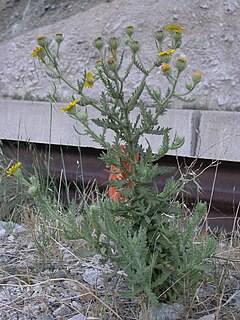
Senecio adenotrichius is a species of the genus Senecio. It is native to Chile, and common on disturbed land there.
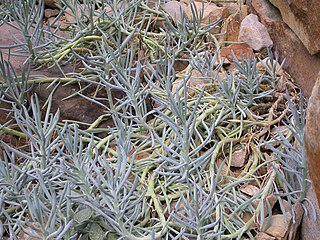
Curio ficoides, syn. Senecio ficoides, also known as skyscraper Senecio and Mount Everest Senecio, is a species of succulent plant, in the genus Curio (Asteraceae), indigenous to South Africa.

Senecio fremontii, the dwarf mountain ragwort, is a species of the family Asteraceae. It takes its scientific name from John C. Frémont.
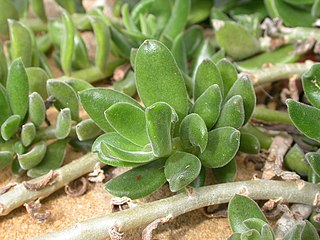
Kleinia implexa is a species of flowering plant in the genus Kleinia and family Asteraceae which was previously considered to be a species of Senecio.

Kleinia petraea is a species of flowering plant in the genus Kleinia and family Asteraceae which was previously considered to be a species of Senecio. Native to Kenya and Tanzania, it is colloquially known as creeping jade, trailing jade or weeping jade due to its resemblance to the unrelated Jade plant. It is grown as a garden plant as a groundcover or in hanging baskets.

Senecio kleiniiformis is a species of flowering plant in the genus Senecio and family Asteraceae. It was previously considered to be in the genus Kleinia. This species is thought to be found only in cultivation. Its leaves are blue-green and triangular shaped. Its pale yellow blooms attract butterflies at the end of summer and early fall. This species is drought tolerant and fire resistant, but it cannot survive frost.
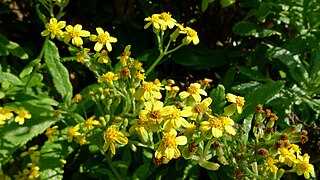
Senecio madagascariensis, also known as Madagascar ragwort, is a species of the genus Senecio and family Asteraceae that is native to Southern Africa. Other common names include Madagascar groundsel and fireweed. It has been included on the noxious weeds list for Hawaii and the reject list for Australia. S.madagascariensis is the diploid cytotype of S.inaequidens.

Senecio nevadensis is a species of flowering plant in the family Asteraceae.

Senecio tripinnatifidus is a species of the genus Senecio and family Asteraceae and is a native of Chile.

Curio archeri, syn. Senecio toxotis is a species of succulent plant in the family Asteraceaethat is indigenous to the south-western Cape, South Africa.
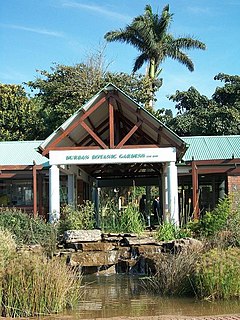
The Durban Botanic Gardens is situated in the city of Durban, KwaZulu-Natal, South Africa. It is Durban's oldest public institution and Africa's oldest surviving botanical gardens. The gardens cover an area of 15 hectares in a subtropical climate.
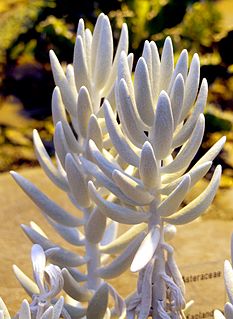
Caputia is a small genus of flowering plants in the family Asteraceae, native to South Africa. It may be of hybrid origin. Species in this genus were formerly considered part of the genus Senecio.


















